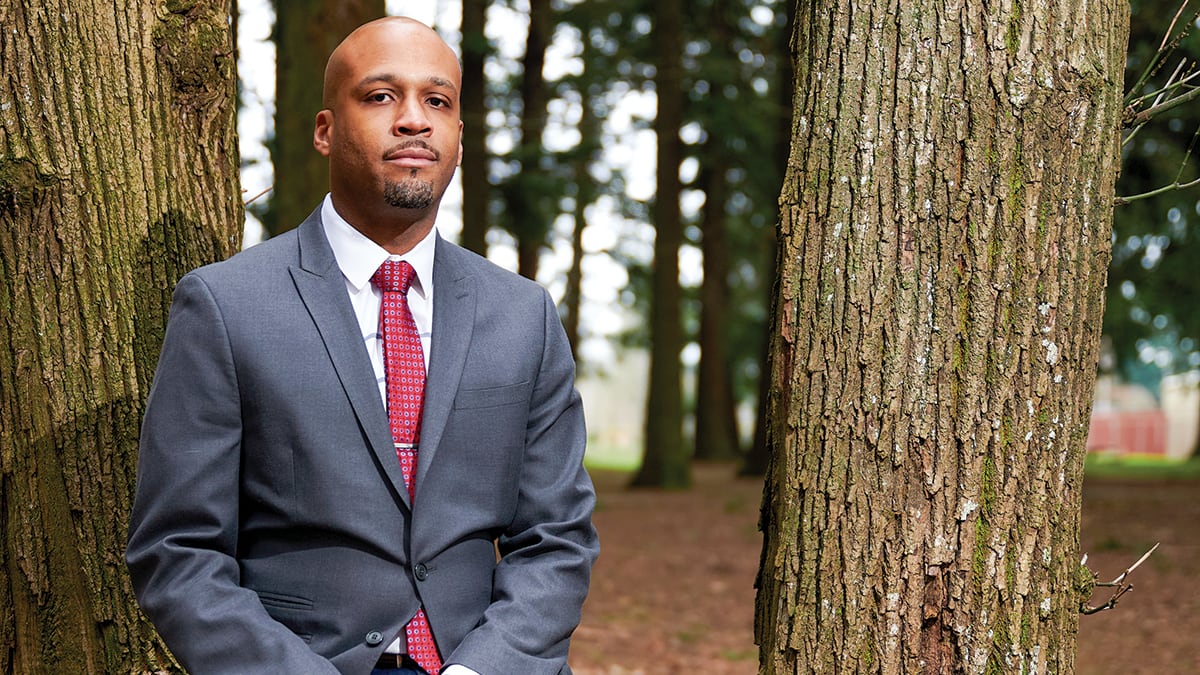Ashton Simpson has a simple wish for 2022: He’d like his neighbors not to die while crossing the street to their tents.
Simpson, 36, is executive director of Oregon Walks, which advocates for safer streets. Portland is heading in the wrong direction on that front, having racked up a record 67 traffic deaths in 2021.
Last March, Oregon Walks published a comprehensive analysis of three years of pedestrian deaths. The findings: Drivers speeding down wide streets that often lack crosswalks, sidewalks and adequate lighting are killing and maiming low-income people of color east of Interstate 205.
A soft-spoken former Air Force mechanic, Simpson is emerging as a formidable voice for people often ignored in the halls of power.
“My intention is to make sure that this is a city that starts working for its most vulnerable residents,” says Simpson, who previously worked at the Rosewood Initiative, a neighborhood-improvement nonprofit, and is now running for a seat on the Metro Council. He sees the carnage on eastside streets as part of a systemic failure of city government to invest in the outer eastside.
“I don’t want to be seen as an angry Black man,” he says. “I am angry, but I’m angry for a reason.”
WW: What do you hope for in 2022?
Ashton Simpson: Number one, we have to grapple with our homeless situation. A third of our pedestrian fatalities this year and last were folks living on the streets. We’ve got to take care of them. Second, east of I-205 is almost a forgotten land. I’m tired of seeing downtown being fine-tuned. We need to absolutely make sure every corner down there is Americans with Disabilities Act accessible, for example. But you can get around pretty well downtown. In communities out here where there is no sidewalk at all, people are dying.
What’s the solution to homeless people dying in traffic?
First, it’s triage. We’ve got identify folks and try to get them into a shelter and connect them to services. Number two, the Portland Bureau of Transportation is going to have to say, “No camping on freeways or off-ramps.”
In 2015, the Portland City Council unanimously passed Vision Zero, which was supposed to end traffic crash deaths and serious injuries by 2025. The city has spent more than $120 million, but things have gotten worse. Why?
Vision Zero is a great program, but it’s running on the equivalent of a 1989 Mac or PC. Think of our streets as the hardware—you can interject any program that you like, but it’s not going to change much because you first have to change behavior and you have to change the built environment.
PBOT failed to install a single new speed camera for at least three years. What do you make of that?
Mismanagement? We know the cameras force drivers to slow down. The money is there—where’s the urgency?
We’ve seen a big increase in traffic deaths and gun violence both concentrated in East Portland. Is there a connection?
What I see is a lack of a concerted effort to invest in these communities. Black folks often feel like the government doesn’t give a damn about us. We don’t need a huge police presence. We do need to expand Portland Street Response so that we can get folks out of harm’s way when they’re dealing with the Portland Police Bureau. But I would love to see us shrink the police budget and invest more in opportunities—like construction apprenticeships.
You’re on the Interstate 5 bridge replacement committee. What’s your vision?
We do need a new bridge, and it has to include bus rapid transit. We don’t need a lot of lanes. If we really are serious about our climate goals, that drives everything. We also need walking and biking lanes and to look how light rail can shape what is a hundred-year bridge. We’re going have vehicles and freight moving across the bridge. However, we need to try to reduce single-occupancy trips as much as possible.
How?
We should move to a fare-free system so that we make it more attractive and convenient. And that also takes away the heavy enforcement element on transit that criminalizes our youth.
Cities such as Cleveland and Detroit have been shrinking for decades, with a loss of tax revenue and services. Portland’s been growing for decades. So why are things getting worse instead of better?
It seems like there’s a good-old-boy system with the haves maintaining their control over how things are shaped. Power begets power, right? Money buys power, power buys policy that continues the will of power. It’s a cycle.
The City Council talks a lot about equity. What do you see on the ground in East Portland?
To quote James Baldwin, “I hear what you say, but I see what you do.” The problem that we’re having in these eastside communities has been a problem for decades. After the summer of Breonna Taylor and George Floyd, we hoped to see change. But nothing’s changed—and it’s infuriating. Just because we don’t live in fancy homes and we don’t live near the city center and we don’t have the thousands of dollars to throw in political contributions, we are ignored.
I came back from vacation the day before the Timbers’ championship game. At the airport, it was all green and gold and they sure cleaned up downtown. But then I get back to Northeast 122nd Avenue and Siskyou Street and nobody had come and helped those folks living off that freeway ramp.
